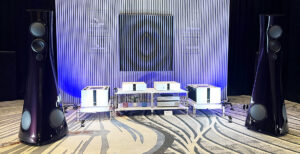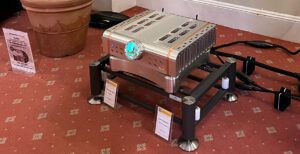
We recently scurried down to deepest, darkest Devon to chew the fat with Simon Heyworth at his beautiful state-of-the-art Super Audio Mastering (SAM) facility. Simon kicked off his audio career in the early-‘70s at Virgin’s The Manor studio – where he co-produced Tubular Bells – before going on to establish himself as one of the most talented mastering engineers on the planet. As well as mastering hundreds of new albums since SAM opened its doors back in 2002, Simon has also been responsible for numerous critically-acclaimed re-masters including Nick Drake, Brian Eno, King Crimson, George Harrison and Simple Minds.
Over a two-part interview – and with the help of fellow SAM engineer Andy Miles – Heyworth explains the ins and outs of the complex creative process in which he “polishes” fresh-from-the-studio mixes into the high-end sonic gems you can all enjoy on your hi-fis.

MF: How would you sum up what the mastering process is all about?
SH: “The simple way to look at it is if you’re a carpenter, you go and make a table and you make a really nice table and you go, ‘Yeah, that looks okay, that’s nice… but it’s not finished’. Now, there’s a guy down the road who is really good at polishing and that’s us. And I think it’s as simple as that really. We’re just the polishers! The polishing can either be polishing out imperfections or it can be polishing something up to a shine… with what we do, we like people to go, ‘Wow, I never knew it could sound that good! You seem to have breathed new life into this’ and these are the kind of comments that we get. The other thing we do of course is provide a purely technical service of providing masters for CD-pressing, downloading audio from the internet and a whole myriad of data compression services and metadata input. Crucially, we are the last link in the chain of record-making so the quality control aspects are very important such as flagging up the existence of odd noises, ticks and pops and removing them where possible so that the end product is clean.”
MF: And how long do you spend mastering an album on average?
SH: “Well, certainly a day and then the second day is listening back and doing any tweaks that we want to do. It’s usually two days but I’m doing one at the moment which is going to be about a week.”
MF: When an artist or record label comes to you with an album to master, what’s the first step in the process?
SH: “We listen to all the tracks all the way through in a running order and we just sit and make notes. Sometimes we do things together and we both sit and listen.”
AM: “It’s good for focus and trains of thought.”
SH: “You get into the album and you listen to it until you know what to do. The idea is to create something that flows and has a similar kind of a quality to it all the way through. A similar footprint. You can hear immediately if there are problems between each track. Maybe the bass on this one needs to be less or the vocal’s a bit quiet on that one but, generally speaking, every time you play it you learn something new about the song so it’s not just a quick process. We then look at different signal paths based on our notes.”
AM: “Let’s say the tracks were recorded digitally, then the first decision is choosing whether you want to go into the analogue domain or whether you want to do it digitally. If you are going to go for the analogue route, then you have to choose what D-to-A [digital-to-analogue converter] to use and, after that, you need to decide what [outboard effects] boxes to use and then what A-to-D [analogue-to-digital converter] to use.”
SH: “We have three different types of D-to-A and A-to-D and they all have different qualities and it always depends on the music. Just that very simple action of going through a good quality D-to-A can be enough to make the music better. It might already sound better than the mix they gave you in the first place.”

MF: Do you find there is always benefit in taking digital recordings into the analogue domain?
SH: “Well, maybe it’s so good that it doesn’t need to go into the analogue world. Traditionally, mastering has always been about taking audio out of the digital world and into the analogue world because it is supposed to sound better but it doesn’t necessarily follow that it is better. It’s different… but does it make it sound better? You know, how much work do I really need to do to this? Do I need to do anything at all or is it just a question of balancing the levels and it’s all done? We have to make all these judgement calls. What analogue seems to do is to add humanity to the stuff and that’s the weird bit about analogue. It’s not necessarily warmth but it just seems to add space or something. It does something that’s hard to explain.”
MF: With analogue mastering, what can be involved with different signal paths?
SH: “Well, we have various different analogue boxes [including high-end gear manufactured by Avalon, Manley, Millennia, Thermionic Culture, Chiswick Reach, Maselec and SSL] which mean we can add various EQs, compression, limiting and other effects. Each will give a footprint or a sound, although we try to keep the signal paths as transparent as possible. All these little boxes do things and we say, you know, ‘Does that bring anything to the party? Does that make it better?’ We use the word ‘glue’ quite a bit because these analogue boxes that we use do provide glue. I mean, we have one piece of kit called the [Maselec] MTC-2, which is actually a mastering console but I put it in the way of my mastering console [an SPL MMC1] and I use it as an effects box. It has stereo width, elliptical filter, it has gain in and out, it has inserts, it has a summing device and it’s got lots of little ways of providing this glue. It just kind of sticks it all together and it’s weird. You can run everything flat through it without any controls at all and you still get back glue. It’s wonderful.”
MF: Could you explain the use of compression as far as the mastering process is concerned?
SH: “Well, people use audio compression to decrease the dynamic range in order to squash it to make things sound punchy. By squashing it, it sounds like it’s trying to get out of a box. It sounds like it’s pushing against the lid if you like and, depending on how much compression you add to it, you can also bring up the low level information. Depending on what ratio of compression it is, you can bring up lower level things within the mix and hold the things that are in the top of the mix from getting any louder. So, you bring up the low level stuff and you can sort of fit it all in and it gives this more compressed sound, which is a bit more present so things like all the low level reverbs and atmospheres and so on and so forth will all come up a bit.”
MF: How about limiting?
SH: “Limiting is about limiting the peaks. You get transient peaks that are really fast and you need something that reacts to that and so limiting is all about holding it, limiting the peaks so that you can get more level. You can raise the level up without it going over the top or over zero, as it were. What you must do is take care not remove the transient or to over-limit, unless you are looking for that effect and the audio demands this processing.”
MF: And EQ?
SH: “EQ or equalisation is basically adding treble or bass or taking it away if it’s too much and even-ing it out so that there’s not too much of either. If it’s a bit honky, you might take out some of the low-mid and if it’s too hard, you might take out some of the mid. If it’s too bright, you might take out some of the higher-mid frequencies, just to kind of smooth things out. Equalising is basically adding treble and bass essentially or taking it away. But you can have just as much effect by taking out than you can with putting in and taking out can be more effective. With taking out, you can unmask something. You can find that the frequency is masking another frequency so, if you pull the one that’s masking out, suddenly everything comes clear in the mix.”
By Hi-Fi+ Staff
More articles from this authorRead Next From Blog
See all
AXPONA 2024 Show Report Part One
- Apr 19, 2024

Audio Show Deluxe 2024: A photo show report
- Mar 28, 2024

Paul Messenger 1949-2024: A personal tribute
- Mar 26, 2024

Bristol Hi-Fi Show 2024: See You There!
- Feb 21, 2024










